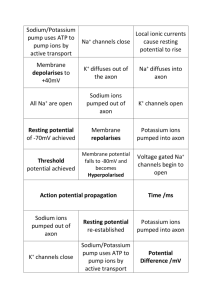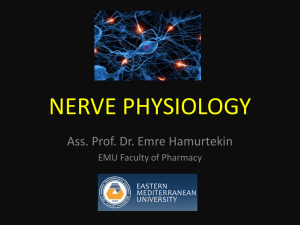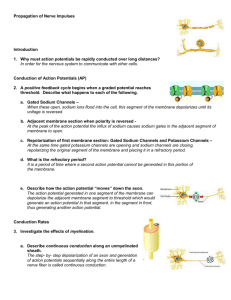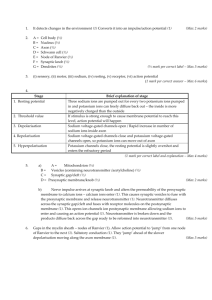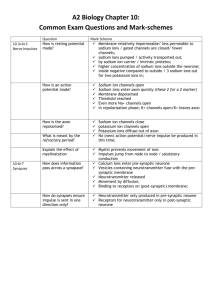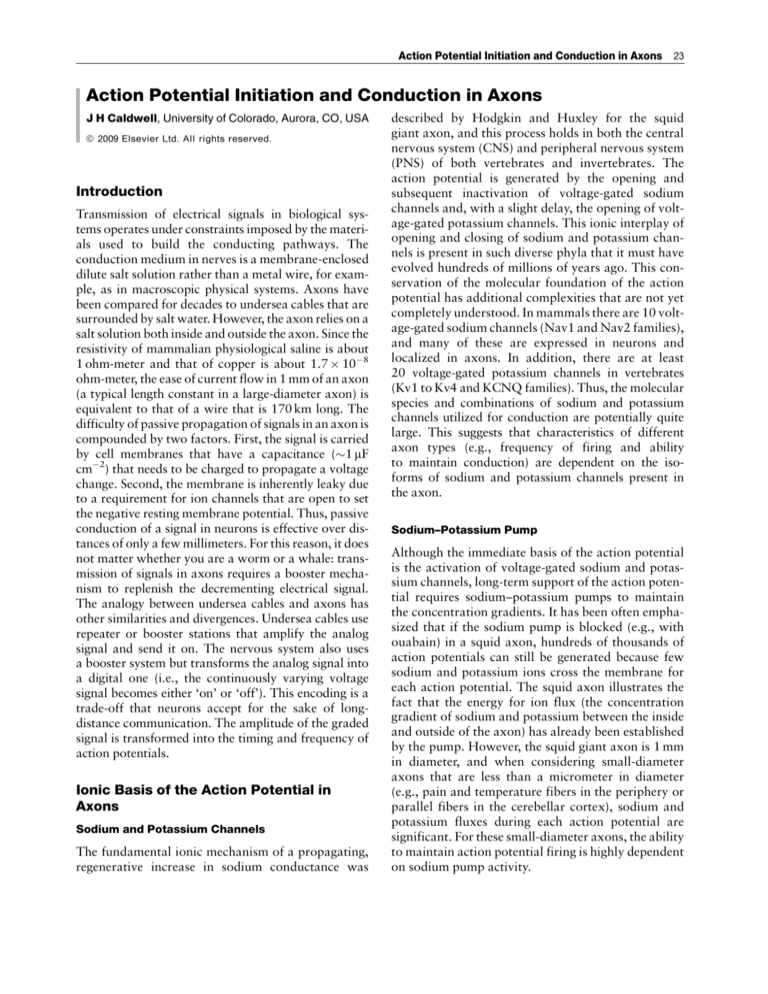
Action Potential Initiation and Conduction in Axons
23
Action Potential Initiation and Conduction in Axons
J H Caldwell, University of Colorado, Aurora, CO, USA
ã 2009 Elsevier Ltd. All rights reserved.
Introduction
Transmission of electrical signals in biological systems operates under constraints imposed by the materials used to build the conducting pathways. The
conduction medium in nerves is a membrane-enclosed
dilute salt solution rather than a metal wire, for example, as in macroscopic physical systems. Axons have
been compared for decades to undersea cables that are
surrounded by salt water. However, the axon relies on a
salt solution both inside and outside the axon. Since the
resistivity of mammalian physiological saline is about
1 ohm-meter and that of copper is about 1.7 ! 10"8
ohm-meter, the ease of current flow in 1 mm of an axon
(a typical length constant in a large-diameter axon) is
equivalent to that of a wire that is 170 km long. The
difficulty of passive propagation of signals in an axon is
compounded by two factors. First, the signal is carried
by cell membranes that have a capacitance (#1 mF
cm"2) that needs to be charged to propagate a voltage
change. Second, the membrane is inherently leaky due
to a requirement for ion channels that are open to set
the negative resting membrane potential. Thus, passive
conduction of a signal in neurons is effective over distances of only a few millimeters. For this reason, it does
not matter whether you are a worm or a whale: transmission of signals in axons requires a booster mechanism to replenish the decrementing electrical signal.
The analogy between undersea cables and axons has
other similarities and divergences. Undersea cables use
repeater or booster stations that amplify the analog
signal and send it on. The nervous system also uses
a booster system but transforms the analog signal into
a digital one (i.e., the continuously varying voltage
signal becomes either ‘on’ or ‘off’). This encoding is a
trade-off that neurons accept for the sake of longdistance communication. The amplitude of the graded
signal is transformed into the timing and frequency of
action potentials.
Ionic Basis of the Action Potential in
Axons
Sodium and Potassium Channels
The fundamental ionic mechanism of a propagating,
regenerative increase in sodium conductance was
described by Hodgkin and Huxley for the squid
giant axon, and this process holds in both the central
nervous system (CNS) and peripheral nervous system
(PNS) of both vertebrates and invertebrates. The
action potential is generated by the opening and
subsequent inactivation of voltage-gated sodium
channels and, with a slight delay, the opening of voltage-gated potassium channels. This ionic interplay of
opening and closing of sodium and potassium channels is present in such diverse phyla that it must have
evolved hundreds of millions of years ago. This conservation of the molecular foundation of the action
potential has additional complexities that are not yet
completely understood. In mammals there are 10 voltage-gated sodium channels (Nav1 and Nav2 families),
and many of these are expressed in neurons and
localized in axons. In addition, there are at least
20 voltage-gated potassium channels in vertebrates
(Kv1 to Kv4 and KCNQ families). Thus, the molecular
species and combinations of sodium and potassium
channels utilized for conduction are potentially quite
large. This suggests that characteristics of different
axon types (e.g., frequency of firing and ability
to maintain conduction) are dependent on the isoforms of sodium and potassium channels present in
the axon.
Sodium–Potassium Pump
Although the immediate basis of the action potential
is the activation of voltage-gated sodium and potassium channels, long-term support of the action potential requires sodium–potassium pumps to maintain
the concentration gradients. It has been often emphasized that if the sodium pump is blocked (e.g., with
ouabain) in a squid axon, hundreds of thousands of
action potentials can still be generated because few
sodium and potassium ions cross the membrane for
each action potential. The squid axon illustrates the
fact that the energy for ion flux (the concentration
gradient of sodium and potassium between the inside
and outside of the axon) has already been established
by the pump. However, the squid giant axon is 1 mm
in diameter, and when considering small-diameter
axons that are less than a micrometer in diameter
(e.g., pain and temperature fibers in the periphery or
parallel fibers in the cerebellar cortex), sodium and
potassium fluxes during each action potential are
significant. For these small-diameter axons, the ability
to maintain action potential firing is highly dependent
on sodium pump activity.
24 Action Potential Initiation and Conduction in Axons
Structural and Functional Differences of
Vertebrate Axons
Axons fall into two major categories depending on the
structure of the glial cells that envelop them. The first
category is the unmyelinated axon, which describes all
invertebrate axons and small axons of vertebrates,
typically axons with a diameter below 1 mm. The
unmyelinated axon is usually loosely surrounded by
a glial cell or in some cases, such as parallel fibers in
the cerebellar molecular layer, is not covered by a glial
cell. The speed of conduction of an action potential in
an unmyelinated axon is proportional to the square
root of the axon diameter. Thus, invertebrates have
large-diameter axons for signals that need to be propagated rapidly. The squid giant axon, which is part of
a circuit used for rapid propulsion in the escape
response, is as large as 1 mm in diameter, conducts at
25 m s"1 (at 25 $ C), and is formed by the fusion of
axons of many neurons.
Vertebrates have evolved an alternative strategy for
increasing the speed of action potential conduction.
Vertebrate axons larger than about 1 mm are tightly
wrapped by many layers of the glial cell, creating the
second category, the myelinated axon. Myelination
occurs in a repeating pattern, with long wrapped
regions (internodes that are up to 1–2 mm in length)
interrupted by a very short bare region (the node of
Ranvier, 1–2 mm in length). In the PNS the glial cell is
a Schwann cell. Each Schwann cell can envelop many
unmyelinated axons, but when myelination occurs,
one Schwann cell is devoted to the formation of one
myelinated internode. Myelin in the CNS is formed
by oligodendrocytes, and one oligodendrocyte sends
out tens of processes, each one forming an internode
on a different axon. Functionally, the myelin acts as
an insulator, by reducing the leak of current through
the membrane in the internodal regions. The myelin
also reduces the effective capacitance of the internodal region, which in turn reduces the capacitive
current required to charge the internodal membrane.
Consequently, current travels rapidly with little loss
in the internodal regions to the node of Ranvier,
where the current is boosted or regenerated by voltage-gated sodium channels concentrated at the node
(described later). Conduction velocity in myelinated
axons is proportional to the axon diameter, and the
general rule of thumb is that for axons with an outside diameter greater than 11 mm, the speed of conduction, in meters per second, is about six times the
axon diameter, in micrometers. For smaller axons the
proportionality factor is 4.5. An axon 20 mm in diameter, which is one of the largest in the mammalian
nervous system, conducts at 120 m s"1, about five
times faster than the squid axon, even though it is
50 times smaller. Thus, myelination not only
increases speed of conduction, but also does this
with an economy of space. This concept of economizing the volume used for conduction is invoked to
explain why we have many more unmyelinated
axons than myelinated ones: more information can
be carried in a given volume with small, unmyelinated
axons. In the mammalian nervous system, pain and
temperature information is carried by small, unmyelinated axons in the PNS, and the molecular layer of
the cerebellum in the CNS is densely packed with
parallel fibers that are unmyelinated axons of granule
cells.
Initiation of the Action Potential
Stimulation Required for Electrogenesis
A rapid membrane depolarization is necessary to open
voltage-gated sodium channels and start the action
potential. This depolarization can be achieved artificially by inserting a microelectrode into an axon and
injecting current, by extracellularly stimulating an
axon with an electrode, or even by mechanically hitting the nerve – for example, when we hit our ‘funny
bone’ (the ulnar nerve near the elbow). Naturally
produced depolarizations fall into two categories.
For most neurons, synaptic input to the dendrites
and cell body provides the required depolarization.
Sensory neurons, such as stretch receptors in muscle
or cutaneous receptors in the skin, propagate action
potentials centrally; a sensory signal in the periphery
creates a depolarization called the receptor or generator potential that opens sodium channels to produce
action potentials.
Site of Initiation
Unmyelinated axons The simplest treatment of a
neuron separates it into three regions: soma, dendrite,
and axon. The elementary concept of a passive dendritic tree that simply receives excitatory and inhibitory synaptic inputs and sends these inputs to the
cell body, where they are summated, is now known to
be an oversimplification. Many neurons have voltagedependent sodium and calcium channels in dendrites.
However, only in rare cases can dendrites initiate
action potentials that are propagated orthodromically to the soma. Thus, the integration of excitatory
and inhibitory potentials takes place at the soma. The
soma contains a variety of voltage-gated channels,
but sodium channel density is highest at the axon
hillock, an enlargement of the axon at the point it
leaves the cell body (Figure 1). For example, sodium
channel density is over sevenfold higher on the initial
segment of a neurite (presumptive nascent axon),
Action Potential Initiation and Conduction in Axons
25
Soma
Axon initial
segment
Axon
hillock
Sodium channel cluster
Node of Ranvier
First myelin
segment
Myelin
internode
Figure 1 Sites of action potential initiation and sodium channel clustering. Action potentials begin at the point of lowest threshold, which
is a function of the balance between sodium, potassium, and leak currents. In general, the action potential originates where sodium
channels are clustered at high density, and for both unmyelinated and myelinated axons this is usually at the axon hillock. In myelinated
neurons initiation can also occur in the initial segment or at the first node of Ranvier, where sodium channels are highly concentrated.
Inset: Four nodes of Ranvier (arrows) in a teased sciatic nerve with nodal labeling by an anti-Nav1.6 antibody (red) and paranodal labeling
with an anti-Caspr antibody (green). The node shown at higher power within the inset is tilted such that the labeling of the entire
circumference of the nodal membrane can be seen. Scale bar ¼ 5 mm (3.3 mm for the tilted node). (Inset) Reproduced from Caldwell JH,
Schaller KL, Lasher RS, et al. (2000) Sodium channel Na(v)1.6 is localized at nodes of Ranvier, dendrites, and synapses. Proceedings of
the National Academy of Sciences of the United States of America 97: 5616–5620.
compared to the soma in cultured spinal cord neurons. The higher density at the axon hillock has been
confirmed with immunolabeling of neurons in many
regions of the CNS. The main consequence of the
increased sodium channel density at the axon hillock
is that the threshold for action potential initiation is
lowest there. Thus, for unmyelinated axons, action
potential initiation takes place at the axon hillock.
Myelinated axons The site of action potential origination in myelinated axons was also shown to be the
axon hillock about 50 years ago. More recently, with
improvements in the ability to measure voltage
changes optically and with patch clamp electrodes,
the precise location of the origin of the action potential has been identified. Action potentials can originate not only at the axon hillock, but also in the axon
initial segment, 30–40 mm from the soma and close to
the first myelinated segment. In some neurons the
action potential even originates at the first node of
Ranvier, where sodium channels are highly concentrated (Figure 1). For both myelinated and unmyelinated axons, once the action potential begins in the
axon, it not only propagates orthodromically toward
the nerve terminals but also propagates antidromically, back into the soma and dendrites.
Conduction in Unmyelinated and
Myelinated Axons
Unmyelinated Axons
Before considering a propagating action potential, it
is useful to understand the currents that underlie a
stationary action potential. It is possible to control
the membrane potential experimentally along the
length of an axon. In this case, a short stimulus current
can be applied to bring the entire length of membrane
to threshold, and the whole axon subsequently and
simultaneously undergoes an action potential. Once
the applied stimulus is over, total membrane current in
this artificial situation is zero. Since membrane current is the sum of capacitive and ionic currents, ionic
and capacitive currents are equal and opposite. Ionic
currents through sodium and potassium channels
simply change the membrane potential by charging
membrane capacitance. For a propagating action
potential, the relationship between ionic and capacitive currents is more complex (Figure 2). The reason
for this complexity is that once the action potential is
initiated, either by transduction of a sensory stimulus
or by summation of postsynaptic potentials, sodium
current in the active region not only depolarizes the
active region further, but also provides depolarizing
26 Action Potential Initiation and Conduction in Axons
Direction of propagation
Vm
+
0
Membrane
potential
−
Capacitive
current
Outward
Repolarization
Inward
Outward
Depolarization
Ionic
current
Potassium
efflux
Sodium
influx
Inward
Refractory
10 cm (large myelinated axons)
Figure 2 Ionic and capacitive currents that underlie a propagating action potential. The membrane potential change of an action
potential propagating from left to right is illustrated at the top.
Capacitive and ionic currents are schematically shown below
the membrane potential and are drawn to illustrate the major
relationships. Since capacitive current is proportional to the first
derivative of the membrane potential, peak capacitive currents
occur at the maximum slopes of depolarization and repolarization,
and capacitive current is zero at the peak of the action potential.
Total membrane current (the sum of capacitive and ionic
currents) is proportional to the second derivative of the membrane
potential and is zero at the maxima of the capacitive current where
total current changes between inward and outward (yellow to red
boundary and red to green boundary in the schematic of the axon
at the bottom). For an action potential propagating at a constant
velocity, the scale bar at the bottom can be thought of as time at a
fixed point on the axon (typical action potential duration is 1 ms)
or as distance over which the action potential is occurring at
one instant of time (10 cm for an action potential with a duration
of 1 ms and conduction velocity of 100 m s"1). A series of myelinated nodes is shown above the scale bar to illustrate that
many nodes participate at any given time. For the fastest conducting axons, there would be five times as many nodes as are
illustrated here.
current to the adjacent region of the axon at the
leading edge of the action potential to bring it
beyond threshold (Figure 2). The depolarization at
the leading edge of the action potential is primarily
a capacitive current until threshold is reached.
Current also spreads longitudinally behind the
action potential, but an action potential is not
created in the retrograde or backward direction
because of the residual changes in the state of
potassium and sodium channels. Potassium channels are still activated and are holding the membrane potential near the resting potential while
sodium channels in this region are still recovering
from the depolarization; they are inactivated, and
this part of the axon is temporarily refractory to
action potential generation.
The conduction velocity of unmyelinated axons
depends on how much current is injected into the
axon by the sodium channels, how far the current
can spread longitudinally, and how quickly the adjacent membrane can be brought to threshold. The
amount of current depends on the density of sodium
channels. Since more sodium channels provide more
current, one might think that an increase in channel
density will always increase conduction velocity. This
proportionality is valid only for low to moderate
sodium channel densities because the channels act as
dipoles (the source of their voltage sensitivity) and
add additional capacitance to the membrane. The
time required to charge the membrane is the product
of the specific membrane resistance and capacitance.
At very high channel density, the effect of the added
capacitance outweighs the additional current provided because it takes longer to charge the membrane
and conduction velocity is decreased. Typical sodium
channel density of unmyelinated axons is 50–500
channels mm"2, with potassium channel density
about tenfold lower. An especially low density (2–3
channels mm"2) has been reported in garfish olfactory
nerve and neonatal rat optic nerve.
Channel subtypes In general, all neurons express
multiple subtypes of sodium and potassium channels.
All channel subtypes in the Nav1 sodium channel
family have the basic features described by Hodgkin
and Huxley over 50 years ago; they are activated by
depolarization, with subsequent inactivation that is
removed when the membrane is repolarized. Ion
selectivity seems to be the same for all the subtypes,
but the details of voltage dependence, the kinetics of
opening and closing, and the modulation of these
gating properties vary from one subtype to another.
The multiplicity of potassium channel subtypes is
much greater than that of sodium channels, and
their properties are also more variable.
There is evidence that neurons use different channel subtypes in subcellular regions of the cell. This
would allow the cell to fine-tune the excitability of
the cell in different regions. The expression and
targeting of different sodium and potassium channel
Action Potential Initiation and Conduction in Axons
proteins to the unmyelinated axon remain an active
area of research. Some sodium channel subtypes in
the PNS, such as Nav1.8 and Nav1.9, seem to be
predominantly expressed in small dorsal root ganglion neurons and are targeted to unmyelinated
axons. Parallel fibers in the cerebellar cortex utilize
Nav1.6.
Myelinated Axons
The current available for depolarizing the next axonal segment to threshold is dependent on the loss of
current through the membrane (its leakiness) and the
decrease due to capacitive current required to charge
the membrane and change the membrane potential. The
number of wraps of the axon by the myelin and
the length of the myelin internode have important
electrical consequences for both the ionic and the
capacitive currents. Since the extracellular fluid
between each wrap is squeezed to a negligible volume
and since the cytoplasm is also squeezed out of the
glial wraps, the axonal membrane is essentially
increased in thickness by the myelin membranes. The
number of wraps by myelin varies from a low of about
10 to as many as 150, with each wrap consisting of a
pair of membranes. For example, a large myelinated
axon with 150 wraps will decrease ionic current loss
through the internodal membrane by a factor of 300.
Because capacitance is inversely related to the distance
between the charged surfaces (in this case the thickness of a membrane), capacitance and capacitive current will also be reduced 300-fold. The current thus
moves rapidly in the internode, with little loss through
the membrane or in charging the membrane, essentially jumping from one node to the next. This is
described as saltatory conduction. Each node acts as a
booster station to ensure propagation to the next node,
and to accomplish this regeneration of the signal,
sodium channels are highly concentrated at each node
(2000–3000 channels mm"2) and are about 100-fold
lower in density in the internodal membrane.
Increasing the internodal distance increases the
speed of conduction because the current is jumping
farther. However, there is an optimal internodal
length. If internodal distances were to become very
large, conduction velocity is predicted to decrease.
This decrease in velocity is due to the loss of current
in the internodal region, slowing the rate of rise of
depolarization at the next node. Internodal distances
are found to be about 100-fold greater than the axon
diameter (in agreement with internodal distances predicted to optimize the conduction speed) and range
from a few hundred micrometers to 1–2 mm.
The mental image of an action potential occupying
a single node and hopping from one node to the next
27
is a common misconception. Although the action
potential is jumping from one node to the next at
the leading edge, many nodes are simultaneously participating. The extent of axons actively involved in
the action potential is dependent on the speed of
conduction. The fastest conducting myelinated fibers
have a speed of 100–120 m s"1. If the action potential
duration is 1 ms, an action potential traveling at
100 m s"1 will, at a given instant of time, occupy
10 cm of the axon, or approximately 100 nodes,
since the internodal length is on the order of 1 mm
for large-diameter axons (Figure 2).
A measure of the reliability of conduction is called
the safety factor, which is defined as the current in
excess of that required to reach threshold and maintain propagation. A safety factor of 2 means that the
current generated by the sodium channels is twice the
minimum needed for conduction. Axons have a safety
factor of about 5, and this excess is important because
it speeds conduction (allowing the membrane to
reach threshold faster) and provides the extra current
needed at branch points. Axons branch hundreds of
times, each branch imposing an increased load on
the current provided by the upstream axonal membrane. If several branches occur close together, conduction can fail in some branches, especially during
high-frequency firing. For similar reasons, additional
current is also needed at the synaptic terminal where
additional membrane must be depolarized. The internodal distances in motor axons decrease as the
synaptic terminal is approached, and in some cases
are as short as 10–20 mm. The effect of decreasing
internodal distance is to concentrate nodes of Ranvier
near the synaptic terminal, to provide the necessary
current for terminal depolarization. It is not known if
the terminals have sodium channels, since immunolabeling with antibodies specific for voltage-gated
sodium channels have failed to show this.
Channel subtypes Many subtypes of sodium channels can be targeted to nodes of Ranvier, and during
development several subtypes are found at neonatal
nodes. In the adult mammal almost all nodes of Ranvier in the PNS and CNS contain predominantly
one subtype, Nav1.6. The switch between neonatal
and adult subtypes at the node coincides with the
formation of compact myelin. Three types of potassium channels have been identified pharmacologically (inward rectifier, slow outward rectifier, and
4-aminopyridine-sensitive channels) and attributed
primarily to internodal membrane. Subtype-specific
antibodies have shown that Kv1.1, Kv1.2, and Kv1.4
are present in the internodal region, with the highest
density in the juxtaparanodal region at the boundary
28 Action Potential Initiation and Conduction in Axons
Juxtaparanode
Membrane
Paranode Node
Kv chan
Kv chan
Kv chan
Kv chan
Axon interior
Membrane
Na channel
K channel
Na–K pump
Kv channel
Figure 3 Ion channels and pumps concentrated in the vicinity of the node of Ranvier. Saltatory conduction in myelinated nerves is
dependent on a high concentration of sodium channels at the node of Ranvier, to provide the inward current needed for depolarization of
the next node. Repolarization is accomplished not only by inactivation of the sodium channels but also by a high resting potassium
conductance at the node (KCNQ potassium channels) and by voltage-gated potassium channels excluded from the node and concentrated in the juxtaparanodal region near the node. Sodium–potassium pumps are concentrated at the node to maintain the concentration
gradients. The thickness of the membrane (5 nm) is highly exaggerated relative to the axon diameter (>1 mm).
of the paranode. In addition, there is a high resting
potassium conductance at some nodes, and a high
concentration of KCNQ2 and possibly KCNQ3
potassium channels is co-extensive with the high concentration of sodium channels at the node. These
separate highly aggregated clusters of channels are
illustrated in Figure 3. As mentioned earlier, the flux
of sodium and potassium ions needed to charge and
discharge the membrane for each action potential is
small, but maintenance of the ion gradients is dependent on sodium–potassium pumps. These pumps are
highly concentrated in the nodal membrane.
Summary
The essential features of action potential initiation
and propagation were determined over 50 years ago.
Research into the electrical excitability of neurons is,
however, far from moribund. Recent advances in molecular biology have revealed a multiplicity of sodium
and potassium channel subtypes in neurons. Subtle
changes in the activation, inactivation, and kinetics
of voltage-gated sodium and potassium channels are
predicted to have large effects on action potential
threshold and rate of firing. The subcellular placement
of specific isoforms and the modulation of these isoforms are also critical parameters of neuronal excitability. Many basic questions at the cellular and
subcellular level remain. What is the lifetime of these
channels in different regions, such as the axon hillock,
initial segment, or node of Ranvier? Are there intracellular pools of the channels that can be rapidly
inserted to provide plasticity at the level of conduction? What are the signals that target channels to
the nodal region and adjacent paranodal and juxtaparanodal regions of myelinated axons? How does the
cell achieve a balance between channel synthesis and
degradation in the cell body, as well as insertion
and retrieval at specific sites such as the node of
Ranvier? How is the distribution of channels established during development? Maintenance of electrical excitability during adulthood is a process of
continual remodeling that requires constant feedback
with signals from target cells and interactions with
glial cells. These molecular signals and interactions
remain unknown.
See also: Demyelinating Diseases; Demyelination and
Demyelinating Antibodies; Ion Channel Localization in
Axons; Myelin: Molecular Architecture of CNS and PNS
Myelin Sheath; Schwann Cells and Axon Relationship;
Sodium Channels; Voltage Gated Potassium Channels:
Structure and Function of Kv1 to Kv9 Subfamilies;
Voltage-Gated Potassium Channels (Kv10–Kv12).
Further Reading
Ariyasu RG, Nichol JA, and Ellisman MH (1985) Localization of
sodium/potassium adenosine triphosphatase in multiple cell
types of the murine nervous system with antibodies raised
against the enzyme from kidney. Journal of Neuroscience 5:
2581–2596.
Baker M, Bostock H, Grafe P, et al. (1987) Function and distribution of three types of rectifying channel in rat spinal root myelinated axons. Journal of Physiology 383: 45–67.
Boiko T, Van Wart A, Caldwell JH, et al. (2003) Functional
specialization of the axon initial segment by isoformspecific sodium channel targeting. Journal of Neuroscience 23:
2306–2313.
Caldwell JH, Schaller KL, Lasher RS, et al. (2000) Sodium channel
Na(v)1.6 is localized at nodes of Ranvier, dendrites, and
synapses. Proceedings of the National Academy of Sciences of
the United States of America 97: 5616–5620.
Catterall WA (1981) Localization of sodium channels in cultured
neural cells. Journal of Neuroscience 1: 777–783.
Action Potential Initiation and Conduction in Axons
Colbert CM and Johnston D (1996) Axonal action-potential initiation and Naþ channel densities in the soma and axon initial
segment of subicular pyramidal neurons. Journal of Neuroscience 16: 6676–6686.
Hodgkin AL (1975) The optimum density of sodium channels in an
unmyelinated nerve. Philosophical Transactions of the Royal
Society of London 270: 297–300.
Jack JJB, Noble D, and Tsien RW (1975) Electric Current Flow in
Excitable Cells. London: Oxford University Press.
29
Nicholls JG, Martin AR, Wallace BG, et al. (2001) From Neuron to
Brain, 4th edn. Sunderland, MA: Sinauer Associates.
Palmer LM and Stuart GJ (2006) Site of action potential initiation
in layer 5 pyramidal neurons. Journal of Neuroscience 26:
1854–1863.
Quick DC, Kennedy WR, and Donaldson L (1979) Dimensions of
myelinated nerve fibers near the motor and sensory terminals in
cat tenuissimus muscles. Neuroscience 4: 1089–1096.

